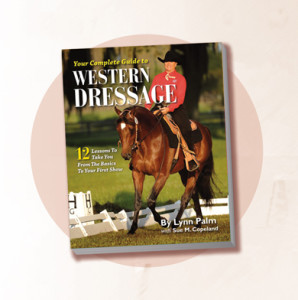Your Complete Guide to Western Dressage – Book Review
Click here to read the complete article
12 Lessons to Take You from the Basics to Your First Show – by Lynn Palm with Sue M. Copeland
By Dale Leatherman, Editor, DiscoverHorses.com
If you still believe that “Western” and “dressage” don’t belong in the same sentence, you’re in a dwindling minority. Over the years, the training of horses has evolved, leaving behind the rough, one-method-fits-all “breaking” of young horses and the heavy use of bit and spur in developing performance horses. Trainers in all disciplines now recognize the value of patient and humane interaction with each horse as an individual and potential partner.
That’s the root of Western Dressage, which brings together modern Western horsemanship and the classical training methods used by Europeans hundreds of years ago to develop war horses with lightness, rhythm and balance. And isn’t that what we all want from our horses?
You won’t have to give up your Stetson for a top hat or derby and a tight collar—and you may never compete in a Western Dressage class. But the more you learn about dressage (French for “training”), the more you’ll see how it can help any horse, whether he’s used for cutting cattle, trail riding, barrel racing or Western Pleasure classes.
Lynn Palm, winner of more than 34 AQHA world and reserve world championships, has used dressage to train her horses for more than 40 years. Working with award-winning equestrian journalist Sue M. Copeland, Palm now shares her experience and knowledge in Your Complete Guide to Western Dressage: 12 Lessons to Take You from the Basics to Your First Show.
The 80-page, 8- by 10-inch book is just the right format for a busy horse person, with images and diagrams to illustrate each of the exercises. The goals: showing you how to use your reins, seat and legs to improve your horse’s collection, balance and rhythm—and your own balance.
Your reining horse must have balance to do a sliding stop with his front end light enough to walk a few steps. If your Western Pleasure horse isn’t collected, he’ll be pulling himself along with his front legs rather than having smooth, long strides. Does your trail horse stumble over poles on the ground? Does your horse delay lead changes, or change with his front legs first, or sometimes not change behind? Then this book is for you. Even if your horse does not have obvious faults, there’s always room for improvement.
“We use dressage on all of our all-around horses,” says Palm. “Balance makes any athletic endeavor easy for them. When his job is easy, your horse wants to do it. It’s why our horses have a reputation for ‘working happy.’ Yours will, too, when you add dressage to your training program.”
Throughout the book Palm begins each lesson with “What it is” and “Why it helps,” and then describes “How to do it” in easy steps with great illustrations. By Lesson 9 your horse could be doing a shoulder in, turn on the haunches, and turn on the forehand with the best of them—and showing better straightness, energy, balance and rhythm.
Western Dressage is not only about making your horse better. Chapter 5 addresses how to improve your position and balance so you don’t interfere with your horse.
“To illustrate how much your body position can affect your horse’s body, imagine carrying a 2-year-old child on your shoulders,” Palm writes. “If the child is rambunctious, he’ll squirm and you’ll constantly have to adjust your body and stride length to stay balanced beneath him. He can even make it hard to walk a straight line! . . . The same is true for your horse. When you’re balanced, he relaxes and is able to maintain a clear, consistent rhythm. If he loses his rhythm slightly, you’ll be able to feel it, and can regain it through the use of your aids.”
By Chapter 10 you may want to see how you and your horse stack up in an actual Western Dressage test. This chapter, in which Palm walks you through a practice test, is loaded with illustrations—and tips, such as how to use your peripheral vision, when to cue your horse for transitions, and how to make your circles round.
This book just may get you hooked on the idea of competing in Western Dressage. If so, Chapters 11 and 12 guide you through everything you need to know, from show day prep to the actual ride before judges.
“You don’t have to compete to benefit from Western dressage,” says Palm. “You can use it to improve communication with your horse, and his suppleness and responsiveness, regardless of your chosen discipline.”
At the back of the book is a bonus section—several sample tests provided by the Western Dressage Association of America (westerndressageassociation.org).
Your Complete Guide to Western Dressage: 12 Lessons to Take You from the Basics to Your First Show, by Lynn Palm with Sue M. Copeland, is available for $24.95+s&h from www.HorseBooksEtc.com.











